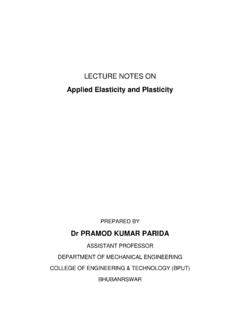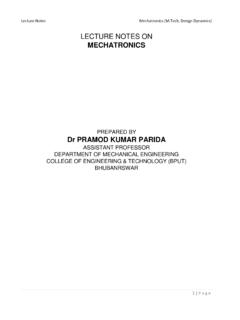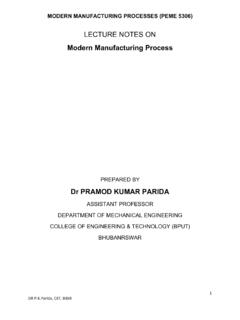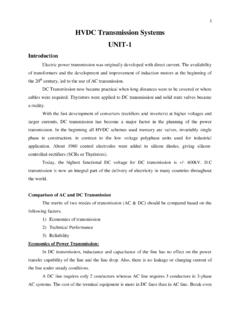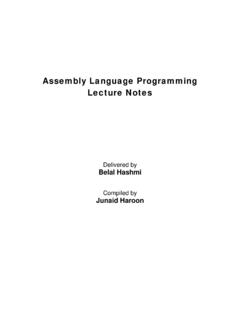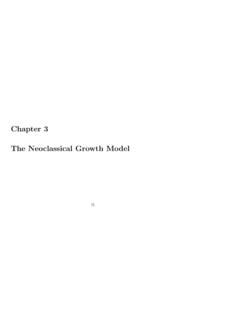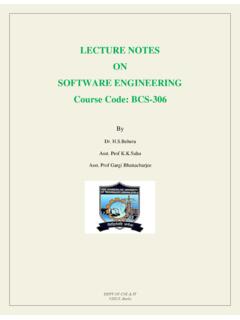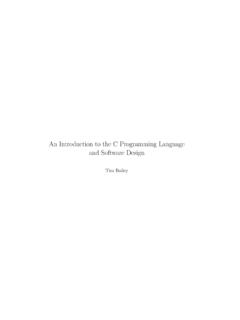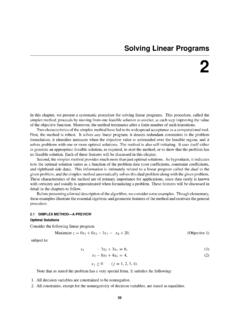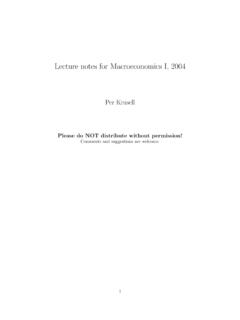Transcription of Object Oriented Programming Using C++
1 Object Oriented Programming Using C++ 2 lecture notes ON Object Oriented Programming Using C++ Prepared by Dr. Subasish Mohapatra Department of Computer Science and Application College of Engineering and Technology, Bhubaneswar Biju Patnaik University of Technology, Odisha 3 SYLLABUS PCCS2207 Object Oriented Programming Module I Introduction to Object Oriented Programming , user defined types, structures, unions, polymorphism, encapsulation. Getting started with C++ syntax, data-type, variables, strings, functions, default values in functions, recursion, namespaces, operators, flow control, arrays and pointers.
2 Module II Abstraction mechanism: Classes, private, public, constructors, destructors, member data, member functions, inline function, friend functions, static members, and references. Inheritance: Class hierarchy, derived classes, single inheritance, multiple, multilevel, hybrid inheritance, role of virtual base class, constructor and destructor execution, base initialization Using derived class constructors. Polymorphism: Binding, Static binding, Dynamic binding, Static polymorphism: Function Overloading, Ambiguity in function overloading, Dynamic polymorphism: Base class pointer, Object slicing, late binding, method overriding with virtual functions, pure virtual functions, abstract classes.
3 Operator Overloading: This pointer, applications of this pointer, Operator function, member and non member operator function, operator overloading, I/O operators. Exception handling: Try, throw, and catch, exceptions and derived classes, function exception declaration, unexpected exceptions, exception when handling exceptions, resource capture and release. Module III Dynamic memory management, new and delete operators, Object copying, copy constructor, assignment operator, virtual destructor. Template: template classes, template functions. Standard Template Library: Fundamental idea about string, iterators, hashes, iostreams and other types. Namespaces: user defined namespaces, namespaces provided by library.
4 Object Oriented Design, design and Programming , role of classes. Text Books: 1. Object Oriented Programming with C++ by E. Balagurusamy, McGraw-Hill Education (India) 2. ANSI and Turbo C++ by Ashoke N. Kamthane, Pearson Education Reference Books: 1. Big C++ - Wiley India 2. C++: The Complete Reference- Schildt, McGraw-Hill Education (India) 3. C++ and Object Oriented Programming Jana, PHI Learning. 4. Object Oriented Programming with C++ - Rajiv Sahay, Oxford 5. Mastering C++ - Venugopal, McGraw-Hill Education (India) 4 CONTENTS lecture 01: Introduction lecture 02: Object Oriented Programming lecture 03: BASIC CONCEPTS OF OBJECTS Oriented Programming lecture 04: BENEFITS OF OOP lecture 05: Basics of C++ lecture 06: Tokens lecture 07: Basic Data types in C++ lecture 08: Symbolic Constant lecture 09: Operators lecture 10: Control Structures lecture 11: Functions in C++ lecture 12: Function Overloading lecture 13: Class lecture 14: Member Function lecture 15: Nesting of Member function lecture 16: Array with Class lecture 17: Static Data Member lecture 18.
5 Friendly functions lecture 19: Returning Objects lecture 20: Constructors lecture 21: Destructors lecture 22 & 23: Operator Overloading lecture 24: Type Conversion lecture 25: Class to Basic type lecture 26: Inheritance lecture 27: Multilevel Inheritance lecture 28: Hierarchical Inheritance lecture 29: Virtual Base Class lecture 30: Polymorphism lecture 31: Virtual functions lecture 32: Pure Virtual Functions lecture 33: C++ function overriding lecture 34: Exception Handling lecture 35: Array reference out of bound lecture 36: Containership in C++ lecture 37: Template lecture 38: Class Template lecture 39: Virtual destructors lecture 40: Managing Console I/O lecture 41: Namespaces lecture 42: New & Delete Operators 5 Module-1: lecture -1 Introduction: Programmers write instructions in various Programming languages to perform their computation tasks such as: (i) Machine level Language (ii) Assembly level Language (iii) High level Language Machine level Language : Machine code or machine language is a set of instructions executed directly by a computer's central processing unit (CPU).
6 Each instruction performs a very specific task, such as a load, a jump, or an ALU operation on a unit of data in a CPU register or memory. Every program directly executed by a CPU is made up of a series of such instructions. Assembly level Language : An assembly language (or assembler language) is a low-level Programming language for a computer, or other programmable device, in which there is a very strong (generally one-to-one) correspondence between the language and the architecture's machine code instructions. Assembly language is converted into executable machine code by a utility program referred to as an assembler; the conversion process is referred to as assembly, or assembling the code.
7 High level Language : High-level language is any Programming language that enables development of a program in much simpler Programming context and is generally independent of the computer's hardware architecture. High-level language has a higher level of abstraction from the computer, and focuses more on the Programming logic rather than the underlying hardware components such as memory addressing and register utilization. The first high-level Programming languages were designed in the 1950s. Now there are dozens of different languages, including Ada , Algol, BASIC, COBOL, C, C++, JAVA, FORTRAN, LISP, Pascal, and Prolog. Such languages are considered high-level because they are closer to human languages and farther from machine languages.
8 In contrast, assembly languages are considered low-level because they are very close to machine languages. The high-level Programming languages are broadly categorized in to two categories: (iv) Procedure Oriented Programming (POP) language. (v) Object Oriented Programming (OOP) language. 6 Procedure Oriented Programming Language In the procedure Oriented approach, the problem is viewed as sequence of things to be done such as reading , calculation and printing. Procedure Oriented Programming basically consist of writing a list of instruction or actions for the computer to follow and organizing these instruction into groups known as functions.
9 Main program Function-1 Function-2 Function-3 The disadvantage of the procedure Oriented Programming languages is: 1. Global data access 2. It does not model real word problem very well 3. No data hiding Global data Global data Function-1 Function-2 Function-3 Local data Local data Local data Characteristics of procedure Oriented Programming : 1. Emphasis is on doing things(algorithm) 2. Large programs are divided into smaller programs known as functions. 3. Most of the functions share global data 4. Data move openly around the system from function to function 5. Function transforms data from one form to another.
10 6. Employs top-down approach in program design 7 lecture -2 Object Oriented Programing Object Oriented Programming as an approach that provides a way of modularizing programs by creating partitioned memory area for both data and functions that can be used as templates for creating copies of such modules on demand . Object A Object B Data Data Communication Functions Functions Object C Functions Data Features of the Object Oriented Programming 1. Emphasis is on doing rather than procedure. 2. programs are divided into what are known as objects.
